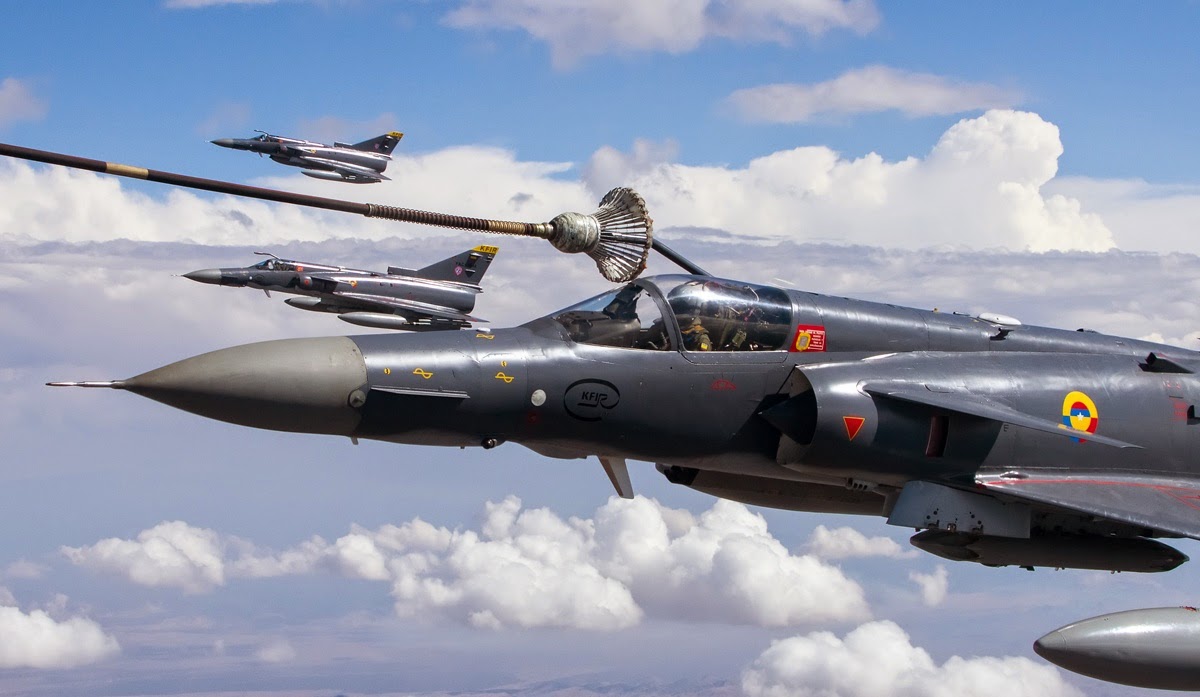3004Views 9Comments

Argentina reportedly halts (on-and-off) IAI Kfir Block-60 talks
Flight Global reports that Argentina has – again – halted negotiations for 12-14 Israel Aerospace Industries (IAI) Kfir Block-60 multi-role fighters. Argentina had resumed stalled talks in March.
It is not known why Argentina had walked away from negotiations. News reports peg the causes of prior stalls to technical concerns over the aircraft and regulatory concerns regarding the transfer of American systems, such as General Electric J79 turbojet engines. Pricing was also reportedly an issue.
The Argentinian Air Force is currently undergoing a recapitalization program involving the acquisition of new aircraft, among them trainers and helicopters.
In April, Argentina issued an order for four Beechcraft T-6C Texan II trainers for $88.2 million U.S. In 2016 the U.S. had approved the sale of 24 T-6C trainers to Argentina for $300 million (with requisite logistics, training and after-sale support). Argentina could potentially order another eight T-6Cs in the near-term.
However, the pursuit of a next-generation combat aircraft platform to replace the Argentinian Air Force’s Lockheed Martin A-4ARs has been a perennial challenge. Buenos Aires had cast a broad net for possible successors, even including non-traditional options from Russia and China.
Argentina had even engaged the Aviation Industry Corporation of China (AVIC) and Pakistan Aeronautical Complex (PAC) regarding the JF-17 Thunder multi-role fighter. However, Buenos Aires walked away from the platform, reportedly due to the risk of cost-escalation from incorporating Western avionics.
Since then, Argentina has been pursuing the IAI Kfir Block-60. The marquee feature of the Kfir Block-60 is that is that is available with the Elta EL/M-2052 active electronically-scanned array (AESA) radar.
Notes & Comments:
While matters fell through the previous time, Argentina may remain as one of AVIC and PAC’s standard-bearer markets for the JF-17. Simply put, it would be a gateway to the Latin American market, which is in the process of region-wide defence modernization and acquisition efforts.
The JF-17 program has seen substantive progress since Argentina had expressed interest in the platform. With more than 70 aircraft in service with five Pakistan Air Force (PAF) units, PAC is at the second-half of the JF-17 Block-II’s production run. Unlike the JF-17 Block-I, the Block-II is a noticeably customized variant comprising of a mix of Chinese, Western and other electronic subsystems. The dual-seat JF-17B – for operational conversion training – has also flown.
Chengdu Aircraft Industry Group (CAIG) and PAC are also progressing with the JF-17 Block-III, which will be the first major update to the Thunder platform. It will include an AESA radar and, if the JF-17B is of any indication, increased wingspan (for additional stores), reduced wing-loading and three-axis digital fly-by-wire flight control system. While the AESA radar is likely to be Chinese, the PAF could potentially look to further tune the aircraft by incorporating additional third-party subsystems. The integration of ASELPOD targeting pods from Turkey’s Aselsan is an example of this effort.
It is possible that the PAF’s own JF-17 Block-III could align (at least nearer than the Block-I/II) to Argentina’s preferred (Western oriented) configuration. Granted, avionics inputs would have to come from Western vendors that are comfortable with the JF-17, such as Aselsan and Indra. This limits Argentina’s options.
A non-Chinese radar will be a challenge. The issue with a third-party radar (e.g. Leonardo Vixen 1000E) is sourcing medium-range air-to-air missiles (MRAAM) and anti-ship missiles (AShM) from non-Chinese sources. MBDA would necessitate British approval (an obstacle for Argentina), while plausible alternates – e.g. Turkey’s Bozdogan MRAAM and Atmaca AShM – are in the development stage.
If technical aspects are addressed, financing may not be insurmountable. For example, PAC can offer the Argentinian Air Force low-rate or incremental purchasing options (e.g. as was offered to Nigeria). Most of PAC’s production line will support PAF requirements, it is not export-dependent.



9 Comments
by Matthys Jacobs
It will be quite difficult given Argentina’s economic issues.
For Argentina to switch to Eastern base platforms would be costly.
by Manju
Radar is very crucial especially with Chinese radar it means Chinese weapons for sure. Even though Argentina has a thing with UK and it’s hard to access western tech due to that, but still they can opt for Russian platforms which would have no problem despite western sanctions.
by Keyser
Argentina is still in the US influence and will not likely switch to Eastern products (The whole communist menace thing has always loomed large in South and central America) anytime soon. It explains why they are even looking at KFIRS. I doubt they will even look at the JF17.
by Halz
Unfortunately, it was reported a while ago that the Chinese decided not to sell anti ship missiles to Argentina, hence there is little incentive for Argentina to pursue the JF-17
by bill
Russian jets are expensive and Ruskies are unable to provide credit line.
by kaster
Bilal you didn’t write anything about the AW-139. It appeared on 14th August air show and the commentators said something about assembling it in Pakistan.
by sami shahid
Lol… this aircraft looks so obsolete and I guess it’s not even battle proven. Argentina should buy JF-17 from Pakistan.
by Amir Timur
Bilal, kindly do a piece on the JF-17 Thunder in terms of air superiority. I’d been reading some credible reports on India’s HAL and it’s program with regards to the Sukhoi Su-30MKI. This will probably be their war horse against the PAF. How well does our defense hold against it? Also, can the Thunder incorporate some elements of air superiority in future blocks, given China’s own experience in projects such as the J-16 derived from the flanker? Sooner rather than later, we’ll need another platform, apart from the JF-17, to complement it’s mainstay roles. And it will have to be something other than knocked down F-16s. FGFAs still are a long way to go, and we won’t contribute in a strategic imbalance by inducting one before the Indians do. Therefore, options such as the J-10 and J-16 need to be weighed in. Either the Thunder’s capabilities have to be expanded, of we need another aircraft altogether.
by Aamir
The Kfir was used by the USN as aggressor aircraft, the Israelis used it extensively in all actions/ conflicts since 1975. It a heavily upgraded Mirage 5.
Here is a link: https://en.m.wikipedia.org/wiki/IAI_Kfir